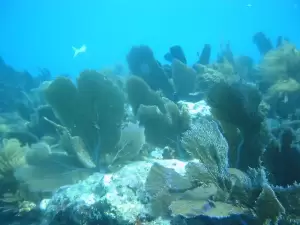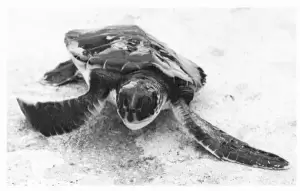Natural and Artificial Reefs

The coral reef ecosystem is complex, dense, delicate, and more diverse than any other aquatic habitat. The reef is made from calcium carbonate (limestone) housing that each tiny, star-like coral forms around its base. As colonies of corals compete for space and dead colonies are replaced, these skeletal cups grow on top of each other to form the reef.
Because of the bountiful diversity of life forms that make coral reef communities their home, they are often called “rainforests of the sea.” Algae living within the corals’ tissues contribute by converting sunlight into nutrients that are essential to the construction process. Coral reefs only occur in shallow, tropical waters, because hydra (the living organisms living in the coral) need warmth and algae need sunlight. During the day, hydra withdraw into their homes, but at night, they stretch out their tiny tentacles to gather food. The tentacles, covered with poisonous cells, paralyze small organisms that drift by. Fortunately the sting of most corals is not strong enough to affect humans.
Over 4,000 fish species – nearly one-third of all known marine fish species – have been recorded on reefs, so they support local fishing economies as well as ocean life. Fish come to feed on the algae, keeping them from multiplying too much, which would prevent coral growth. Fish also come to reefs for shelter from larger predators, which are attracted by their presence, as are sea turtles. Some species of fish make the coral reefs their primary home.

Courtesy State of Florida Archives
For as long as anyone can remember, green, leatherback, and especially loggerhead sea turtles have been coming to Palm Beach County’s beaches to lay their eggs. The hawksbill and the rare Kemp’s Ridley turtle are also seen offshore, and nest on rare occasions. The U.S. Fish and Wildlife Service list all of these as “endangered” species except the loggerhead, which is on the list of “threatened” species. Palm Beach County—especially in the Juno Beach area—has the second highest density of sea turtle nests in Florida, higher than most beaches in the United States. Each spring and summer, public and private researchers monitor nests at four county beaches, with required permission from the Florida Fish and Wildlife Conservation Commission.
In 1898 the Lofthus, a 223-foot Norwegian shipping vessel, sank off the shallow coast of Boynton Beach. Over time, a variety of fish, stingrays, anemones, and spiny lobsters made it their home. The Lofthus shipwreck thus became a valuable ecosystem and was designated as Palm Beach County’s first underwater archeological preserve.
Coastal development, accidents, and severe weather have greatly affected and even eliminated many offshore habitats for marine life. To offset this loss of natural reefs, in the l960s Palm Beach County and the West Palm Beach Fishing Club partnered to create an artificial reef. They intentionally sank a 185-foot private yacht (the Mizpah), a 440-foot freighter (the Amaryllis), and a 165-foot navy patrol craft, creating the “East Palm Beach Reef.”
In the 1980s Palm Beach County formed an official committee to manage its artificial reefs, now administered by the Department of Environmental Resources Management. The County has created more than 60 artificial reefs and continued to add more, using rock, steel, or concrete in addition to old ships. Because scuba divers and anglers have more reefs to choose from, natural reefs undergo less stress, thanks to the presence of their artificial equivalents.

